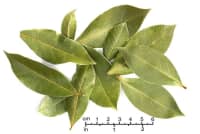Bay Leaf is an aromatic leaf commonly used in cooking. It can be used whole, or as dried and ground.
Bay Leaves may come from several different plants such as:
- Bay laurel (Laurus nobilis, Lauraceae)
- California bay leaf – the leaf of the California bay tree (Umbellularia californica, Lauraceae), also known as California laurel, Oregon myrtle, and pepperwood, is similar to the Mediterranean bay laurel, but has a stronger flavour.
- Indian bay leaf or malabathrum (Cinnamomum tamala, Lauraceae) differs in that bay laurel leaves are shorter and light to medium green in colour, with one large vein down the length of the leaf, while tejpat (Cinnamonum tamala) leaves are about twice as long and wider, usually olive green in colour, and with three veins down the length of the leaf and is culinarily quite different, having a fragrance and taste similar to cinnamon (cassia) bark, but milder.
- Indonesian bay leaf or Indonesian laurel (salam leaf, Syzygium polyanthum, Myrtaceae) is not commonly found outside Indonesia.
- West Indian bay leaf, the leaf of the West Indian bay tree (Pimenta racemosa, Myrtaceae).
- Mexican bay leaf (Litsea glaucescens, Lauraceae).
Composition
Indonesian bay leaf (Syzygium polyanthum) is rich in flavonoids, alkaloids, terpenes and glycosides.[1]
Healing Properties
Antimicrobial
Antiviral
Anti-Infectious
The Bay Leaf plant can serve as a good compound to treat or inhibit the Novel Coronavirus.[2]
Bay Leaf plant contains Phytoligands which have all demonstrated capabilities as acclamatory inhibitors for Novel Coronavirus.[2:1]
Each phytoligand exhibited the highest binding affinity against COVID-19 Main Protease and are expected to be effective in Covid-19 treatment due to their potential inhibitory activity and/or efficiency in using molecular docking in contrast to Covid-19 Main Protease.[2:2]
Antioxidant
The secondary metabolite compounds contained in Indonesian Bay Leaves is believed to be rich in antioxidant effects so that it has the effect of being able to suppress various oxidative stress conditions that cause damage to various organs due to blood sugar dysregulation.[1:1]
Blood Sugar Regulation
Indonesian Bay Leaves has been shown to improve blood glucose intake to cells which helps maintain blood sugar regulation.[1:2]
Disease / Symptom Treatment
Diabetes
Treatment with Indonesian bay leaf extract was able to reduce blood sugar levels significantly by improving blood glucose intake to cells.[1:3]
At doses of 150-300 mg/kg of Body Weight it was able to reduce blood sugar levels to reach targets below 200 mg/kg Body Weight.[1:4]
- The dominant flavonoids in bay leaf extract are believed to be responsible for the effect of blood glucose regulation.[1:5]
- The content of flavonoids in the leading secondary metabolite compound is believed to play a role in blood glucose regulation.[1:6]
- Flavonoids increase the expression of the GLUT 4 protein in muscle tissue.[1:7]
- Increased expression of GLUT 4 causes an increase in glucose intake into cells.[1:8]
- Increased glucose intake into cells, causes a decrease in the buildup of glucose outside the cells and interstitial tissue, which leads to a decrease in blood glucose levels.[1:9]
Title: Effect of Bay Leaf Extract (Syzygium polyanthum) on Blood Sugar Regulation via GLUT4 Protein Regulation in White Rat Muscle Tissue Induced Aloxan
Publication: Eureka Herb Indonesia
Archive: archive, archive-mirror ↩︎ ↩︎ ↩︎ ↩︎ ↩︎ ↩︎ ↩︎ ↩︎ ↩︎ ↩︎Title: Computational Analysis of the Phytoligands From Bay Leaf (Laurus nobilis) Against COVID-19: Molecular Docking And ADME Analysis
Publication: Council of Life Science: JOURNAL OF BIOINFORMATICS
Archive: archive, archive-mirror ↩︎ ↩︎ ↩︎
